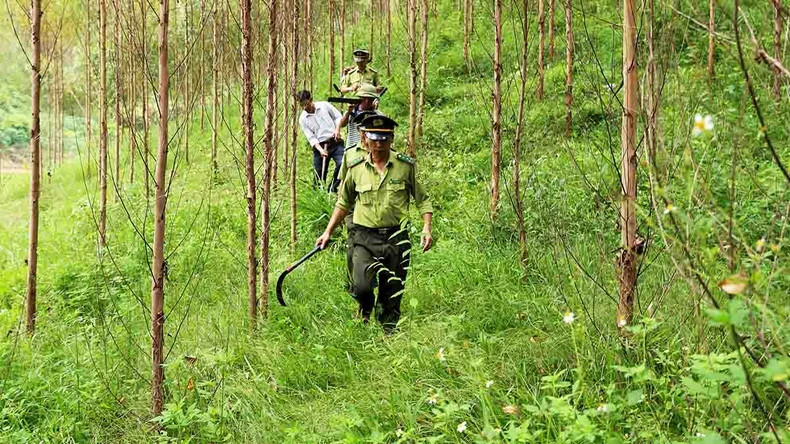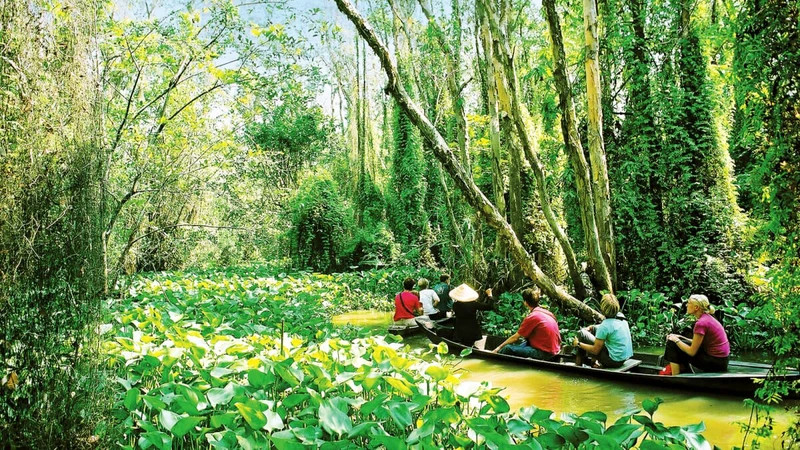The country currently has 14,860,309 hectares of forests, including 10,129,751 hectares of natural forests and 4,730,557 hectares of planted forests.
Sustainable development of large timber forests
According to the Ministry of Agriculture and Rural Development, with more than 3.5 million hectares of production forests, of which about 500,000 hectares of large timber plantations have created an annual supply of wood materials of about 40 million cubic meters, meeting 70% of the needs of the wood processing industry. The forestry industry has built 526 recognised seed sources in 35 out of 63 provinces and cities, with an area of 1,467 hectares, with many high-yield and high-quality forestry plant varieties having been put into large timber production forests.
To date, many provinces have built effective models of large timber production forests, such as Bac Giang, Yen Bai, Quang Ninh, Thanh Hoa, Quang Tri and Ca Mau. The above-mentioned localities have built 770 hectares of afforestation, production and trading models of hybrid acacia and acacia mangium with 310 participating households in 57 communes and 36 districts; built 447 hectares to convert small timber plantations into large timber businesses with 260 participating households, in 34 communes of 21 districts.
Although a large proportion of wood processing needs have been met, in reality, high-quality wood types that meet export needs cannot be met domestically. Every year, businesses still have to import 5 to 7 million m3 of wood to produce wood products for export. Most countries are restricting wood exports, so being self-sufficient in wood materials, especially large trees, is a necessary and timely policy in the current context.
The Government has issued many policies on incentives and investment support in the forestry sector. To promote the development of multi-use values of forest ecosystems, it is necessary to have more appropriate policies to contribute to the sustainable development of the values of forest ecosystems in general and the planting of large timber forests in particular, including taking into account the interests of investors, forest growers and wood processing enterprises.
Tran Quang Bao, Director of the Forestry Department under the Ministry of Agriculture and Rural Development
Until now, many localities have formed several concentrated material afforestation areas; prioritising the development of large timber forests, converting from small timber plantations to large timber businesses, and linking raw material production areas with concentrated commodity processing for several strong products. In the coming time, the proportion of certified wood material supplies from domestically planted forests will be increased to serve the wood and forest products processing industry. More attention will be paid to developing fine processing and deep processing technology, gradually forming a circular economy in the forestry production industry.
Currently, the demand for raw materials from domestic wood and forest product processing enterprises is very large, but more than 30% must be imported from abroad, including some 100% imported materials pushing prices up, and making it difficult to compete. General Director of Tan Vinh Cuu Joint Stock Company (Dong Nai) Vo Quang Ha, said there is nothing better than sustainable development of domestic forest product material areas. Together with the State, investors should accompany localities and people with forests and land to create raw material areas according to business orders. This is the most sustainable and profitable way of development for both farmers and businesses.
The Ministry of Agriculture and Rural Development said that up to now, the whole country has only about 20 production-linked projects in the forestry sector and linked according to Decree No. 98/ND-CP of the Government approved by localities. The rate of value of wood and non-wood forest products produced in new forms of association is only 3.74%. The number of forestry cooperatives currently only accounts for 1.02% (181 cooperatives), cooperative groups account for 1.03% (320 cooperative groups) and 129 farms account for 0.65% of farms in the country.
Chairman of the Vietnam Timber and Forest Products Association (VIFOREST) Do Xuan Lap, said that export businesses using planted forest wood face difficulties, leading to many broken supply chains. The main cause of this situation is the bottleneck in determining the origin of planted forest wood and the legality of transactions at the intermediate stage in the supply chain. This situation occurs because some forest areas lack legal evidence of land sources.
To achieve the set goals, the forestry industry focuses on supporting the development of certified sustainable raw material sources, in accordance with international standards and adaptive raw material sources, minimising the impact of climate change, supporting environmentally friendly raw material processing and developing raw material processing technology.
Increasing the value of non-timber forest products
Forestry industry experts said that non-timber forest products have high value, are light in weight, are easier to transport than wood, recover quickly, can be harvested earlier than wood, and have economic value and productivity; high and stable economy, capable of continuous business, suitable for household size and easily accepted by people.
 |
| Forest rangers coordinate with forest owners to patrol and protect large timber forests in Dong Vuong Commune, Yen The District, Bac Giang Province. (Photo: Vu Sinh) |
According to Dr. Tran Lam Dong, Deputy Director of the Vietnam Academy of Forest Sciences, non-timber forest products are considered an extremely valuable resource for the country. Vietnam has about 7,000 tree species that can produce valuable non-timber forest products. Recently, thanks to the policy of developing the area for planting trees under the forest canopy, many localities with forests tended to promote the cultivation of medicinal plants, bringing high economic efficiency, such as cardamom concentrated in Lai Chau, Lao Cai, Yen Bai, and Ha Giang provinces; amomum concentrates in the provinces of Son La, Lai Chau, Lao Cai, Phu Tho, Thai Nguyen, and Ha Giang; three jacks in the provinces of Quang Ninh, Bac Giang, Vinh Phuc, and Phu Tho; ginseng in Lai Chau, Lao Cai, Kon Tum, and Quang Nam. Since then, many areas have been formed specialising in cultivating several non-timber forest product species to provide raw materials for domestic consumption and export.
Director of The VOS Ecosystem Co., Ltd. Le Hoang The, said that Vietnam already has large timber forests. Hybrid acacia is one of the wood trees that bring high economic value. From the 5th to the 8th year, hybrid acacia trees were exploited. The enterprise has been growing Ganoderma mushrooms under the canopy of hybrid acacia forests since the 4th year. When they reach harvesting age, every 1 kg of mushrooms earns 1 million VND, the mushrooms are harvested three times a year, 1 m2 per year for revenue of 10 million VND from growing mushrooms.
The company also has another product, organic carbon, to participate in the transfer market, bringing sustainable commercial value to businesses and forest growers. Currently, the company sells Ganoderma beverage products and has exported them to the US market. The US Department of Agriculture has issued an Organic product certificate for the Ganoderma mushroom beverage product.
According to the Government’s direction, it is expected that by 2030, the area capable of growing non-timber forest products under concentrated forest canopy will reach at least 200,000 hectares. From there, raw material areas for commodity production are formed and associated with processing facilities based on identifying key crops with advantages in the market.
Dr Tran Lam Dong shared that economic development under the forest canopy is based on two objects: natural forests and production forests. As for natural forests, both in terms of legal and scientific basis, they are currently very difficult to develop, because the regulatory documents are not specific and clear and the risk of leading to forest degradation is very high.
Currently, there is only one object left: production forests that can well develop non-timber forest products, but localities need to take advantage of conditions and resources for sustainable development. Therefore, localities with forests must quickly complete and organise the effective implementation of policies related to developing non-timber forest products. This especially applies to non-timber forest products under the forest canopy, such as allocating, contracting or leasing land for forests to grow medicinal herbs under the forest canopy and properly implement policies on the management of non-timber forest product varieties, policies on investment, capital support, policies on non-timber forest products and taxes.
According to the Department of Forestry under the Ministry of Agriculture and Rural Development, revenue sources of services in forest ecosystems include wood and non-wood forest product supply services, forest environmental services, absorption service and carbon storage, and ecotourism services, which have brought a value of about 40 trillion VND each year.
Director of the Forestry Department Tran Quang Bao, said that forest-based community tourism has been developing quite strongly since 2016. Every year, there are 3 to 4 million visitors participating in tourism. Pu Mat, Cuc Phuong, and Phong Nha-Ke Bang national parks are three of the national parks that have developed community tourism quite well, exploiting the ecological value of forests. Currently, Pu Mat National Park has many community tourism destinations, that have attracted hundreds of workers, with an average income of 4 to 6 million VND/person/month.
In Cuc Phuong National Park, the Muong ethnic community living in the buffer zone alone has about 100 to 200 people participating in tourism, with a regular income of about 7 million VND/month. Deputy Director of Hoang Lien National Park, Mr Vu Duc Quyen shared: "Forest protection must rely on the community, so developing community-based tourism based on people is inevitable. When people have a stable income, forests are better protected."
Another source of revenue is forest environmental services. According to Deputy Director of the Forestry Department Pham Hong Luong, the Project to develop the multi-use value of Vietnam's forest ecosystem by 2030, with a vision to 2050, has just been issued by the Prime Minister and has assigned targets for the forestry sector. Enterprises must strive to ensure stable growth in revenue from forest environmental services, an average of 5%/year. The goal of developing forest environmental services is to specify and expand types of forest environmental services and, at the same time, manage and effectively use resources from forest environmental services in accordance with the provisions of law.
The forestry industry has focused on diversifying and expanding revenue sources from various types of forest environmental services in accordance with the law, especially forest carbon absorption and storage services; reducing greenhouse gas emissions by limiting deforestation and forest degradation, sustainable forest management, and green growth; research and institutionalise regulations on applying rates for forest environmental services that are close to the real value that forests bring, gradually increasing income and stabilising the lives of people directly involved in managing, protecting and developing forests.
According to the Minister of Agriculture and Rural Development Le Minh Hoan, when the value space is expanded, everyone will benefit, there will be no more conflicts and we will find ways to protect and develop forests. The value of the forest must be 10, 100 times higher to be worthy of the words “golden forest”. To do that, it is necessary to “breathe” the soul and bring stories into forest products to increase value. Developing the multi-use value of the forest ecosystem promises to open up “treasures” from the forest. The greatest treasure is not only the benefits and resources, but above all, the mindset of appreciating, cherishing, and cultivating every value of the forest, so that the forest will always be green and give shade to future generations.
On February 29, 2024, the Prime Minister issued Decision No. 208/QD-TTg, approving the Project to develop multi-use values of forest ecosystems until 2030, with a vision to 2050. Accordingly, the project aims to improve the efficiency of management and sustainable use of forest resources; create jobs, increase income and improve the lives of forest workers, promote biodiversity conservation, and adapt to climate change; contributing to ensuring security and national defence.
















